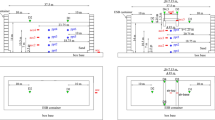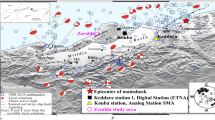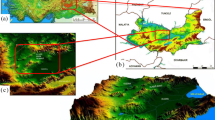Abstract
Evidences from past earthquakes clearly show that the damages due to an earthquake and its severity at a site are controlled mainly by three factors, i.e., earthquake source and path characteristics, local geological and geotechnical characteristics, and structural design and quality of the construction. Seismic ground response at a site is strongly influenced by local geological and geotechnical conditions. The exact information of the geological, geomorphological, and geotechnical data along with seismotectonic details at a particular site are necessary to evaluate the ground response. The geometry of the subsoil structure, the soil type, the lateral discontinuities, and the surface topography will also influence the site response at a particular location. Since the seismic effects on the structure depend fully on the site conditions, research in the area of soil dynamics becomes more useful. The first input required in evaluation of geotechnical aspect of seismic hazard is the rock-level peak horizontal acceleration (PHA) values. The surface-level acceleration values need to be calculated based on the site conditions and site amplification values. This chapter discusses the recent advances in soil dynamics, especially in the area of geotechnical earthquake engineering. The topics covered in this chapter include various methods for evaluating the local site effects, dynamic soil properties, different field and laboratory tests required, various site classification schemes, and different methods to evaluate the surface-level ground motion. In addition to this, the aspects which need to be considered in liquefaction potential evaluation are also discussed.
Access this chapter
Tax calculation will be finalised at checkout
Purchases are for personal use only
Similar content being viewed by others
References
Aki, K. (1988). Local site effects on strong ground motion. Proceedings of the Earthquake Engineering and Soil Dynamics II, Park City, Utah, June 27–30, 103–155.
Anbazhagan, P., & Sitharam, T. G. (2008). Seismic microzonation of Bangalore, India. Journal of Earth System Science, 117, 833–852.
Andrus, R. D., & Stokoe, K. H., II. (2000). Liquefaction resistance of soils from shear wave velocity. Journal of Geotechnical and Geoenvironmental Engineering, 126(11), 1015–1025.
Astroza, M., & Monge, J. (1991). Seismic microzones in the city of Santiago. Relation damage-geological unit. Proceedings of the Fourth International Conference on Seismic Zonation, Earthquake Engineering Research Institute, Stanford, CA, USA, August 25–29, 3, 595–601.
Athanasopoulus, G. A., Pelekis, P. C., & Leonidou, E. A. (1999). Effects of surface topography on seismic ground response in the Egion (Greece) 15 June 1995 earthquake. Soil Dynamics and Earthquake Engineering, 18(2), 135–149.
BIS-1893. (2002). Criteria for earthquake resistant design of structures, part 1 – general provisions and buildings. New Delhi: Bureau of Indian Standards.
BIS-4434. (1978). Code of practice for in-situ vane shear test for soils (first revision). New Delhi: Bureau of Indian Standards.
Borcherdt, R. D. (1994). Estimates of site-dependent response spectra for design (methodology and justification). Earthquake Spectra, 10(4), 617–653.
Borcherdt, R. D., & Gibbs, J. F. (1976). Effects of local geological conditions in the San Francisco Bay region on ground motions and the intensities of the 1906 earthquake. Bulletin of the Seismological Society of America, 66, 467–500.
Bowles, J. E. (1997). Foundation analysis and design. Singapore: McGraw-Hill.
BSSC. (2003). NEHRP recommended provisions for seismic regulations for new buildings and other structures (FEMA 450), part 1: provisions. Washington, DC: Building Seismic Safety Council for the Federal Emergency Management Agency.
Cetin, K. O., Seed, R. B., Kiureghian, D. A., Tokimastu, K., Harder, L. F., Kayen, R. E., et al. (2004). Standard penetration test-based probabilistic and deterministic assessment of seismic soil liquefaction potential. Journal of Geotechnical and Geoenvironmental Engineering, 130(12), 1314–1340.
Chávez-García, F. J., Sanchez, L. R., & Hatzfeld, D. (1996). Topographic site effects and HVSR: A comparison between observations and theory. Bulletin of the Seismological Society of America, 86, 1559–1573.
Chiou, B. S.-J., & Youngs, R. R. (2006). PEER-NGA empirical ground motion model for the average horizontal component of peak acceleration and pseudo-spectral acceleration for spectral periods of 0.01 to 10 seconds. Interim Report for USGS Review, 23, 219 pp. http://peer.berkeley.edu/lifelines/repngamodels.html.
Eurocode-8. (2003). BS-EN 1998-1, “Design of structures for earthquake resistance—Part 1: General rules, seismic actions and rules for buildings”. Brussels: European Committee for Standardization.
Evernden, J. F., & Thomson, J. M. (1985). Predicting seismic intensities. In J. I. Ziony (Ed.), Evaluating earthquake hazards in the Los Angeles region — An earth-science perspective, U.S. Geological Survey Professional Paper, 1360, 151–202.
Faccioli, E. (1991). Seismic amplification in the presence of geological and topographic irregularities. In S. Prakash (Ed.), Proceedings of the second international conference on recent advances in geotechnical earthquake engineering and soil dynamics, St. Louis, Missouri, Rolla, MO: University of Missouri-Rolla, 2, 1779–1797.
Fäh, D., Rüttener, E., Noack, T., & Kruspan, P. (1997). Microzonation of the City of Basel. Journal of Seismology, 1, 87–102.
Field, E. H., & Jacob, K. H. (1993). The theoretical response of sedimentary layers to ambient seismic noise. Geophysics Research Letters, 20, 2925–2928.
Geli, L., Bard, P. Y., & Jullen, B. (1988). The effect of topography on earthquake ground motion: A review and new results. Bulletin of the Seismological Society of America, 78, 42–63.
Hunter, J. A., Benjumea, B., Harris, J. B., Miller, R. D., Pullan, S. E., & Burns, R. A. (2002). Surface and downhole shear wave seismic methods for thick soil site investigations. Soil Dynamics and Earthquake Engineering, 22, 931–941.
IBC. (2009). International building code. Washington: International Code Council.
Idriss, I. M. (1990). Response of soft soil sites during earthquakes. Proceedings of Memorial Symposium to Honor Professor H. B. Seed. Berkeley, CA.
Idriss, I. M., & Boulanger, R. W. (2004). Semi-empirical procedures for evaluating liquefaction potential during earth-quakes. Proceedings of 11th Int. Conf. on Soil Dynamics & Earth-quake Engineering & 33d Int. Conf. on Earthquake Geotechnical Engineering, Berkeley, 32–56.
Kagami, H., Okada, S., & Ohta, G. (1988). Versatile application of dense and precision seismic intensity data by an advanced questionnaire survey. Proceedings of 9th World Conference on Earthquake Engineering, 8, 937–942.
Kramer, S. L. (1996). Geotechnical earthquake engineering. Englewood Cliffs, NJ: Prentice Hall Publishers.
Kramer, S. L., & Mayfield, R. T. (2007). Return period of soil liquefaction. Journal of Geotechnical and Geoenvironmental Engineering, 133(7), 802–813.
Langston, C. A. (1979). Structure under mount rainier, Washington, inferred from teleseismic body waves. Bulletin of the Seismological Society of America, 84(B9), 4749–4762.
Liao, S. S. C., Veneziano, D., & Whitman, R. V. (1988). Regression models for evaluating liquefaction probability. Journal of Geotechnical Engineering, 14(4), 389–411.
Lohse, D., Rauhé, R., Bergmann, R., & van der Meer, D. (2004). Granular physics: Creating a dry variety of quicksand. Nature, 432, 689–690.
Lunne, T., Robertson, P. K., & Powell, J. J. M. (1997). Cone penetration testing in geotechnical practice. London: Blackie Academic and Professional.
Matsuoka, M., Wakamatsu, K., Fujimoto, K., & Midorikawa, S. (2005). Nationwide site amplification zoning using GIS-based Japan Engineering Geomorphologic Classification Map. Proceedings of 9th International Conference on Structural Safety and Reliability, 239–246.
Mayer-Rosa, D., & Jimenez, M.-J. (1999). Seismic zoning, recommendations for Switzerland. Vorbereitung: Landeshydrologie und -Geologie, Geologischer Bericht.
Medvedev, J. (1962). Engineering seismology (Vol. 260). Moscow: Academia Nauk Press.
Midorikawa, S. (1987). Prediction of isoseismal map in the Kanto plain due to hypothetical earthquake. Journal of Structural Engineering, 33B, 43–48.
Mukhopadhyay, S., Pandey, Y., Dharmaraju, R., Chauhan, P. K. S., Singh, P., & Dev, A. (2002). Seismic microzonation of Delhi for ground shaking site effects. Current Science, 82, 877–881.
Nakamura, Y. (1989). A method for dynamic characteristics estimation of subsurface using microtremor on the ground surface. Quarterly Report of Railway Technical Research Institute, 30(1), 25–33.
Park, C. B., Miller, R. D., & Xia, J. (1999). Multi-channel analysis of surface waves. Geophysics, 64(3), 800–808.
Reinoso, E., Wrobel, L. C., & Power, H. (1997). Three-dimensional scattering of seismic waves from topographical structures. Soil Dynamics and Earthquake Engineering, 16, 41–61.
Robertson, P. K., & Wride, C. E. (1998). Evaluating cyclic liquefaction potential using the cone penetration test. Canadian Geotechnical Journal, 35(3), 442–459.
Rodriguez-Marek, A., Bray, J. D., & Abrahamson, N. A. (2001). An empirical geotechnical seismic site response procedure. Earthquake Spectra, 17(1), 65–87.
Seed, H. B., & Idriss, I. M. (1971). Simplified procedure for evaluating soil liquefaction potential. Journal of the Soil Mechanics and Foundations Division, 97, 1249–1273.
Seed, H. B., & Peacock, W. H. (1971). Test procedures for measuring soil liquefaction characteristics. Journal of the Geotechnical Engineering Division ASCE, 97(8), 1099–1119.
Seed, H. B., Tokimatsu, K., Harder, L. F., & Chung, R. M. (1984). The influence of SPT procedures in soil liquefaction resistance evaluations. In Report no. UCB/EERC-84/15. Berkeley, CA: Earthquake Engineering Research Center.
Seed, H. B., Wong, R. T., Idriss, I. M., & Tokimastu, K. (1986). Moduli and damping factors for dynamic analysis of cohesionless soils. Journal of Geotechnical Engineering, ASCE, 112(11), 1016–1032.
Seed, R. B., & Harder, L. F. (1990). SPT-based analysis of cyclic pore pressure generation and undrained residual strength. In H.Bolton seed memorial symposium proceedings (Vol. 2). Vancouver, BC: BiTech Publishers Ltd.
Shima, E. (1978). Seismic microzoning map of Tokyo. Proceedings of 2nd International Conference on Microzonation, 1, 433–443.
Sun, J. I., Golesorkhi, R., & Seed, H. B.. (1988). Dynamic moduli and damping ratios for cohesive soils. EERC Report No.UCB/EERC-88/15.
Toprak, S., Holzer, T. L., Bennett, M. J., & Tinsley, J. C. III. (1999). CPT and SPT based probabilistic assessment of liquefaction potential. Proceedings of 7th U.S.-Japan Workshop on Earthquake Resistant Des. of Lifeline Facilities and Countermeasures Against Liquefaction, Technical Report MCEER-99-0019, Multidisciplinary Center for Earthquake Engineering Research, Buffalo, NY, 69–86.
Vipin, K. S., Anbazhagan, P., & Sitharam, T. G. (2010). Probabilistic evaluation of seismic soil liquefaction potential based on SPT data. Natural Hazards, 53, 547–560.
Vipin, K. S., & Sitharam T. G. (2010). Development of site specific design response spectrum based on different codal provisions. 14th Symposium on Earthquake Engineering, IIT Roorkee, 212–223.
Vipin, K. S., & Sitharam, T. G. (2011). Evaluation of liquefaction return period based on local site classes: Probabilistic performance based logic tree approach. International Journal of Geotechnical Engineering, 5, 245–254.
Wald, J. D., & Allen, I. T. (2007). Topographic slope as a proxy for seismic site conditions and amplification. Bulletin of the Seismological Society of America, 97(5), 1379–1395.
Youd, T. L., Idriss, I. M., Andrus, R. D., Arango, I., Castro, G., Christian, J. T., et al. (2001). Liquefaction resistance of soils: Summary report from the 1996 NCEER and 1998 NCEER/NSF workshops on evaluation of liquefaction resistance of soils. Journal of Geotechnical and Geoenvironmental Engineering, 127(10), 817–833.
Youd, T. L., & Noble, S. K. (1997). Liquefaction criteria based on statistical and probabilistic analyses. Proceedings of the NCEER Workshop on Evaluation of Liquefaction Resistance of Soils, Technical Report NCEER-97-0022, Multidisciplinary Center for Earthquake Engineering Research, Buffalo, New York.
Youd, T. L., & Perkins, D. M. (1978). Mapping liquefaction-induced ground failure potential. Journal of the Geotechnical Engineering Division, ASCE, 104, 443–446.
Author information
Authors and Affiliations
Corresponding author
Editor information
Editors and Affiliations
Rights and permissions
Copyright information
© 2018 Springer International Publishing AG, part of Springer Nature
About this chapter
Cite this chapter
Sitharam, T.G., Vipin, K.S., James, N. (2018). Recent Advances in Soil Dynamics Relevant to Geotechnical Earthquake Engineering. In: Sharma, M., Shrikhande, M., Wason, H. (eds) Advances in Indian Earthquake Engineering and Seismology. Springer, Cham. https://doi.org/10.1007/978-3-319-76855-7_9
Download citation
DOI: https://doi.org/10.1007/978-3-319-76855-7_9
Published:
Publisher Name: Springer, Cham
Print ISBN: 978-3-319-76854-0
Online ISBN: 978-3-319-76855-7
eBook Packages: Earth and Environmental ScienceEarth and Environmental Science (R0)




